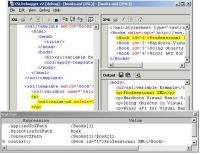The goal of XMLVM is to offer a flexible and extensible cross-compiler toolchain. Instead of cross-compiling on a source code level, XMLVM cross-compiles byte code instructions from Sun Microsystem’s virtual machine and Microsoft’s Common Language Runtime. The benefit of this approach is that byte code instructions are easier to cross-compile and the difficult parsing of a high-level programming language is left to a regular compiler. In XMLVM, byte code-based programs are represented as XML documents. This allows manipulation and translation of XMLVM-based programs using advanced XML technologies such as XSLT, XQuery, and XPath.
Tag: xslt
gotAPI/HTML – Instant search in HTML and other developer documentation
This is a good one-stop-shop with searchable API references for HTML, CSS, JS, PHP, MySQL, XSL and much much more.
WSDL has its constructive logic, but it is hard to read / understand the content by business professionals (mostly non-programmers). Here is a small tool to visualize the web-service in a more intuitive way.
XSL Flickr is a library of templates that allow XSLT (1.0 or 2.0) stylesheets to access the Flickr Services API.
This paper will attempt an objective side-by-side comparison of the two languages: not just from the point of view of technical features, but also looking at usability, vendor support, performance, portability, and other decision factors. Is it true, for example, that XQuery is better for data and XSLT is better for documents? Is one or the other language easier to learn depending on your computing background? As well as trying to answer these questions, the paper will also illustrate how the two languages can interoperate, so that each can be used for the parts of an application where it is most appropriate.
This paper will attempt an objective side-by-side comparison of the two languages: not just from the point of view of technical features, but also looking at usability, vendor support, performance, portability, and other decision factors. Is it true, for example, that XQuery is better for data and XSLT is better for documents? Is one or the other language easier to learn depending on your computing background? As well as trying to answer these questions, the paper will also illustrate how the two languages can interoperate, so that each can be used for the parts of an application where it is most appropriate.
ActiveState XSLT cookbook code samples ratings reviews
Welcome to the XSLT Cookbook, a collaborative collection of techniques from the XSLT community. This living collection allows programmers to be more productive with XSLT.
Signs on the Sand: Detecting version of Microsoft XSLT engine from within XSLT
Sometimes it’s useful to detect which XSLT engine your XSLT stylersheet is being executed by, e.g. to shortcut processing using an engine-specific extension function or to workaround a bug in particlular engine. Now that Microsoft alone ships 3 different XSLT engines – MSXML3/MSXML4/MSXML5/MSXML6, XslTransform and XslCompiledTransform, detecting XSLT engine from within XSLT stylesheet may be vital requirement. Here is how it can be done.
Google AJAXSLT
GOogle code project – XSLT implemented in JavaScript
xslt2Xforms – cross browser W3C Xforms processor
xslt2Xforms is a cross browser “W3C Xforms” processor. This xsl stylesheet adds the W3C Xforms support in your web project using Xhtml, Javascript and Css.
The result code is cross-browser compliant (tested on Internet Explorer 6 and Mozilla 1.7). This stylesheet seems to work with all recent xslt engines.
This is vaporware for the time being but who knows…
Sarissa is a JavaScript meta-API. It bridges the gap of DOM XML extentions between Internet Explorer and Mozilla (or Moz-based) browsers. It is an effort to provide a common interface for those extentions, bringing them closer to eachother.
CSSToXSLFO is a utility which can convert an XML document, together with a CSS2 style sheet, into an XSLFO document. It has special support for the XHTML vocabulary, because that is the most obvious language it would be used for. The tool has a number of page-related extensions. It also comes with an API in the form of an XML filter.
TransQuery – XSLT as Query Language
TransQuery comprises a small, flexible set of XSLT conventions and processing model constraints that enable the use of XSLT as a query language over multiple XML documents. It is an interoperability specification for XML databases, allowing them to use a standard XML query language today–the W3C-recommended XSLT.
You’ve just inherited a new project at work that requires you to learn XSLT, but you don’t have a clue where to start. This article by Michael Fitzgerald should give you a leg up over the wall.

XSLDebugger, a Visual XSLT Debugger
Very nice freeware
Secure XSL Transformations in Microsoft .NET
Read this and then read it again. XSLT can be a security risk, so make sure you take all the necessary precautions
Improve your XSLT coding five ways
Whether you’re a beginner with XSLT or a seasoned programmer, you’ll surely find that these five tips from Benoit Marchal will improve your coding and give you new ideas. The handful of tips cover using CSS with XSL style sheets (including HTML entities), incorporating client-side JavaScript, working with multiple input documents, and using XSLT to generate style sheets automatically. The article includes sample code to adapt and reuse
Sarissa is a JavaScript meta-API. It bridges the gap of DOM XML extentions between Internet Explorer and Mozilla (or Moz-based) browsers. It is an effort to provide a common interface for those extentions, bringing them closer to eachother.
Sarissa implements some of IE extentions for Mozilla. These are:
- The xml property, which gives the serialized XML String of a DOM Object.
- The HTMLElement.innerText property, which gives the text of a node with the tags stripped out
- The DOMDocument.async property, which controls synchronous/asynchronous loading of XML documents
.
XSL Debugger
DHTML based XSL debugger. I’d say it sould be easily embeddable to other applications
xsltMark is a quite comprehensive benchmark for XSLT processors.
It’s also an invaluable resource for links to different XSLT engines;)